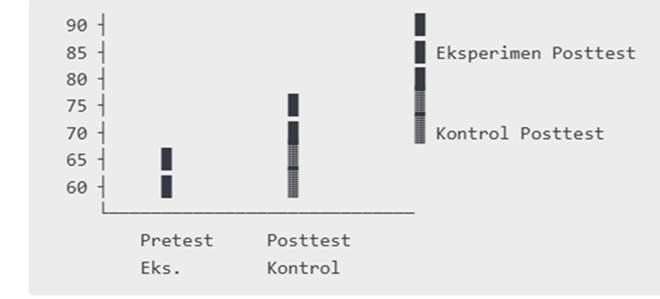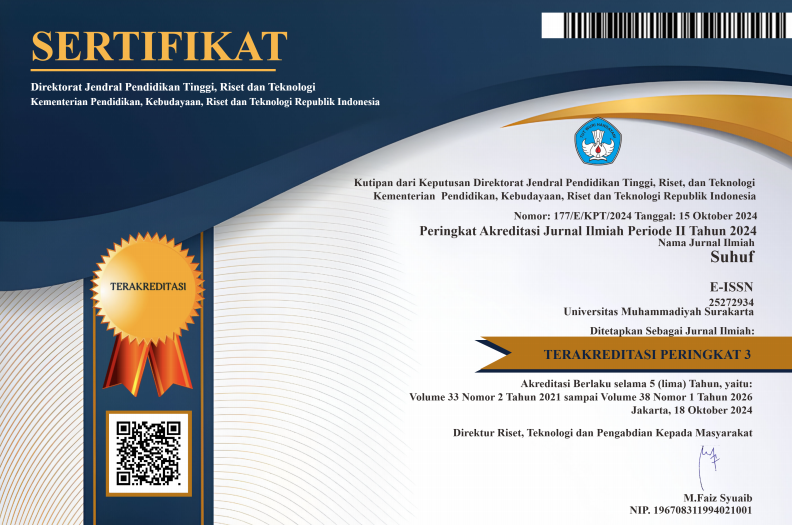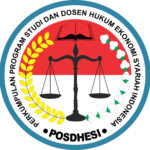Nurturing Islamic Morality Through Stimulus-Response Learning: Evidence from a Quasi-Experiment in Indonesian Elementary Schools
DOI:
https://doi.org/10.23917/suhuf.v37i1.10608Keywords:
Islamic morality, Stimulus-response learning , Quasi-experiment, Elementary education, Indonesian educationAbstract
This study aims to determine the effectiveness of behaviouristic approach in learning Islamic Religious Education (PAI) on moral formation of elementary school students. The study used a quasi-experimental design with a pretest-posttest control group model. The subjects consisted of 50 fifth grade students of SDN 141 Palembang who were divided into two groups: experimental (n=25) and control (n=25). The experimental group received PAI learning with a behaviouristic approach based on positive reinforcement such as praise and symbolic rewards for 8 weeks, while the control group received conventional learning. The research instruments were Likert scale questionnaires and observation sheets. The results of the independent t-test analysis showed that the experimental group experienced a significant increase in the aspects of discipline, honesty, and politeness with an average score of 83.44 compared to the control group with an average score of 71.36. Observations also showed that the consistency of religious behaviour was higher in the experimental group. Thus, the behaviouristic approach has the potential to improve students' moral formation if supported by consistent reinforcement and a conducive learning environment.
Downloads
References
[1] Badan Pemeriksa Keuangan, “Undang - Undang Republik Indonesia No 20 Tahun 2003,” 2003. [Online]. Available: https://peraturan.bpk.go.id/details/43920/uu-no-20-tahun-2003
[2] E. A. Jasmine, S. Yani, M. A. Daulay, I. Kurnia, and M. F. Al Panzil, “Penerapan teori belajar BF Skinner dalam mata pembelajaran PAI [Implementing B.F. Skinner’s Learning Theory in the Teaching of Islamic Religious Education],” El-Mujtama J. Pengabdi. Masy., vol. 4, no. 1, pp. 62–72, (in Indonesia), 2024, doi: https://doi.org/10.47467/elmujtama.v4i1.3160.
[3] S. Suyadi, “Penerapan Teori Belajar Behavioristik Skinner Dalam Pembelajaran Baca Tulis Al-Qur’an: Di SDIT Alam Nurul Islam Yogyakarta [Implementing Skinner’s Behaviorist Learning Theory in Qur’anic Literacy Instruction: A Case Study at SDIT Alam Nurul Islam Yogyakar,” Ulumuddin J. Ilmu-Ilmu Keislam., vol. 11, no. 2, pp. 177–192, (in Indonesia), 2021, doi: https://doi.org/10.47200/ulumuddin.v11i2.895.
[4] D. Intyaswati, W. T. Saputra, S. Maryam, and A. Setiadarma, “Pembiasaan Sholat Dhuha untuk Pembentukan Karakter dan Disiplin Siswa Madrasah Ibtidaiyah Khoirul Huda Depok dengan Metode Participatory Action Research (PAR) [Implementing Dhuha Prayer as a Means of Character and Discipline Formation Among Students at Ma,” Smart Dedication J. Pengabdi. Masy., vol. 2, no. 1, pp. 102–108, (in Indonesia), 2025, doi: https://doi.org/10.70427/smartdedication.v2i1.155.
[5] A. Ihwanah and M. Astuti, “Integrasi Pendekatan Empirisme dan Behaviorisme dalam Pembelajaran PAI di Era Digital [Integrating Empiricist and Behaviorist Approaches in Islamic Religious Education (PAI) in the Digital Age],” Didakt. J. Kependidikan, vol. 13, no. 1, pp. 281–292, (in Indonesia), 2024, doi: https://doi.org/10.58230/27454312.1333.
[6] N. Nurfadillah, A. A. Muis, A. Khaisyurahman, and E. Sapitri, “Behavioristic Learning Theory,” in Proceeding of International Conference on Education, Society and Humanity, 2024, pp. 1268–1274. [Online]. Available: https://ejournal.unuja.ac.id/index.php/icesh/article/view/8039
[7] K. Harto and E. Suryana, Teori dan Pembelajaran: Fondasi Filosofis dan Psikologis untuk Pendidikan Abad 21. Yogyakarta: Semesta Aksara, 2021.
[8] M. Daulay and Y. Karneli, “Pemikiran I. Pavlov dan BF Skinner dan Implementasinya dengan Layanan BK [Theories of I. Pavlov and B.F. Skinner and Their Implementation in Guidance and Counseling (GC) Services],” J. Al-Irsyad J. Bimbing. Konseling Islam, vol. 6, no. 2, pp. 329–350, (in Indonesia), 2024, doi: https://doi.org/10.24952/bki.v6i2.15038.
[9] Halimatuzzahrah and Syamsul Arifin, “Implementation of Behavioristic Theory in Forming Students’ Disciplinary Character in PAI Learning at SDN 1 Taman Ayu,” Bull. Sci. Educ., vol. 4, no. 3 SE-Articles, pp. 238–244, Dec. 2024, doi: https://doi.org/10.51278/bse.v4i3.1586.
[10] N. Robithotul Khoir and A. Ikhwan, “Pembelajaran Behavioristik Madrasah dalam Meningkatkan Motivasi Belajar dan Ibadah Siswa [The Application of Behaviorist Learning in Madrasahs to Enhance Students’ Motivation in Learning and Worship],” J. Pendidik. Nusant., vol. 1, no. 3, pp. 175–185, (in Indonesia), 2022, doi: https://doi.org/10.55080/jpn.v1i3.36.
[11] A. D. Yahya, “Konsep Perkembangan Kognitif Perspektif Al-Ghazali Dan Jean Piaget [Cognitive Development: A Comparative Perspective of Al-Ghazali and Jean Piaget],” KONSELI J. Bimbing. dan Konseling, vol. 5, no. 2, pp. 97–104, (in Indonesia), 2018, doi: https://doi.org/10.24042/kons.v5i2.3501.
[12] M. F. Arib, M. S. Rahayu, R. A. Sidorj, and M. W. Afgani, “Experimental research dalam penelitian pendidikan [The Role of Experimental Research in Educational Research],” Innov. J. Soc. Sci. Res., vol. 4, no. 1, pp. 5497–5511, (in Indonesia), 2024, doi: https://doi.org/10.31004/innovative.v4i1.8468.
[13] Sugiyono, Metode Penelitian Pendidikan Pendekatan Kuantitatif, Kualitatif, dan R&D. Jakarta: Alfabeta, 2013.
[14] D. N. Al Husaeni, A. R. Gintara, G. F. Nabila, and M. Nursalman, “Mengungkap Pentingnya Uji Normalitas dan Homogenitas dalam Penelitian: Studi Kasus dan Aplikasinya [Exploring the Significance of Normality and Homogeneity Testing in Research: Case Studies and Practical Applications],” J. Pendidik. Tambusai, vol. 9, no. 1 SE-Articles of Research, pp. 829–839, (in Indonesia), Jan. 2025, [Online]. Available: http://jptam.org/index.php/jptam/article/view/24268
[15] D. Taluke, R. S. M. Lakat, and A. Sembel, “Analisis preferensi masyarakat dalam pengelolaan ekosistem mangrove di pesisir pantai kecamatan loloda kabupaten halmahera barat [Analysis of Community Preferences in Mangrove Ecosystem Management on the Coastal Area of Loloda District, West Halmahera Reg,” Spasial, vol. 6, no. 2, pp. 531–540, (in Indonesia), 2019, doi: https://doi.org/10.35793/sp.v6i2.25357.
[16] L. Widayati and R. Wijaya, “Implementasi Pendidikan Karakter Disiplin dan Tanggung Jawab Berbasis Tradisi Pesantren di SMP Plus Al Hadi Tuban [The Implementation of Discipline and Responsibility Character Education Based on Pesantren Traditions at SMP Plus Al Hadi Tuban],” Kaji. Moral dan Kewarganegaraan, vol. 12, no. 1 SE-Articles, pp. 119–129, Oct. 2024, doi: https://doi.org/10.26740/kmkn.v12n1.p119-129.
[17] P. G. Subhaktiyasa, “Evaluasi Validitas dan Reliabilitas Instrumen Penelitian Kuantitatif: Sebuah Studi Pustaka [Evaluation of Validity and Reliability in Quantitative Research Instruments: A Literature Review],” J. Educ. Res., vol. 5, no. 4, pp. 5599–5609, (in Indonesia), 2024, doi: https://doi.org/10.37985/jer.v5i4.1747.
[18] I. W. S. Zebua and S. Astuti, “Pengembangan Instrumen Penilaian Sikap untuk Mengungkap Sikap Disiplin Siswa SD [Developing an Attitude Assessment Instrument to Measure Discipline Among Elementary School Students],” J. Basicedu, vol. 8, no. 5, pp. 3877–3887, (in Indonesia), Aug. 2024, doi: https://doi.org/10.31004/basicedu.v8i5.8691.
[19] P. D. W. G. Yuniahans, R. Parlika, R. S. Arhinza, V. F. Majid, and M. G. Alifian, “Uji validitas aplikasi si-book menggunakan SPSS dengan kombinasi metode r-tabel dan cohen’s kappa [Evaluating the Validity of the SI-BOOK Application Using SPSS: A Combined Approach of r-Table Method and Cohen’s Kappa],” J. Teknol. Inf. J. Keilmuan dan Apl. Bid. Tek. Inform., vol. 16, no. 2, pp. 121–133, (in Indonesia), 2022, doi: https://doi.org/10.47111/jti.v16i2.5001.
[20] F. Aryanti, Q. F. P. Wahyono, C. D. Araminta, L. K. Jannah, and E. Kusumastuti, “Uji Validitas dan Reliabilitas Dalam Edukasi Agama Islam Untuk Anak Usia Dini Melalui Film Rara dan Nussa di Era Digital Dengan Software SPSS [An Evaluation of Validity and Reliability in Early Childhood Islamic Education through the Films Rara and Nussa ,” Algoritm. J. Mat. Ilmu Pengetah. Alam, Kebumian dan Angkasa, vol. 2, no. 5, pp. 85–94, (in Indonesia), 2024, doi: https://doi.org/10.31004/basicedu.v6i4.3206.
[21] F. D. P. Anggraini, A. Aprianti, V. A. V. Setyawati, and A. A. Hartanto, “Pembelajaran statistika menggunakan software SPSS untuk uji validitas dan reliabilitas,” J. Basicedu, vol. 6, no. 4, pp. 6491–6504, 2022.
[22] M. Mawardi, “Rambu-rambu penyusunan skala sikap model Likert untuk mengukur sikap siswa [Guidelines for Constructing a Likert-Type Attitude Scale for Assessing Student Attitudes],” Sch. J. Pendidik. Dan Kebud., vol. 9, no. 3, pp. 292–304, (in Indonesia), 2019, doi: https://doi.org/10.24246/j.js.2019.v9.i3.p292-304.
[23] T. D. Hastjarjo, “Rancangan eksperimen-kuasi [Quasi-Experimental Design],” Bul. Psikol., vol. 27, no. 2, pp. 187–203, (in Indonesia), 2019, doi: https://doi.org/10.22146/buletinpsikologi.38619.
[24] T. D. Cook, D. T. Campbell, and A. Day, Quasi-experimentation: Design & analysis issues for field settings, vol. 351. Boston: Houghton Mifflin Boston, 1979. [Online]. Available: https://dickyh.staff.ugm.ac.id/wp/wp-content/uploads/2009/ringkasan buku quasi-experimentakhir.pdf
[25] E. Rahmaniar, M. Maemonah, and I. Mahmudah, “Kritik terhadap teori perkembangan kognitif Piaget pada tahap anak usia sekolah dasar [A Critique of Piaget’s Cognitive Development Theory in the Context of Elementary School-Aged Children],” J. Basicedu, vol. 6, no. 1, 2022, doi: https://doi.org/10.31004/basicedu.v6i1.1952.
[26] A. Sadriani, M. R. S. Ahmad, and I. Arifin, “Peran guru dalam perkembangan teknologi pendidikan di era digital [Teachers’ Role in Advancing Educational Technology in the Digital Age],” in Seminar Nasional Dies Natalis 62, 2023, pp. 32–37, (in Indonesia). doi: https://doi.org/10.59562/semnasdies.v1i1.431.
[27] N. A. H. Sidik, “Pengembangan karakter disiplin dan mandiri siswa melalui pendekatan behavioristik pada masa pandemi Covid-19 di SDI Surya Buana dan SD Anak Saleh Kota Malang,” Universitas Islam Negeri Maulana Malik Ibrahim, 2022. [Online]. Available: http://etheses.uin-malang.ac.id/35120/
[28] Z. Siregar, A. Amin, and A. Suradi, “Upaya guru PAI dalam membentuk karakter religius siswa di SMP Negeri 13 Kota Bengkulu [The Role of Islamic Education Teachers in Developing Students’ Religious Character at SMP Negeri 13, Bengkulu City],” Innov. J. Soc. Sci. Res., vol. 4, no. 3, pp. 11298–11314, (in Indonesia), 2024, doi: https://doi.org/10.31004/innovative.v4i3.11899.
[29] S. Rahmawati and K. Nurachadija, “Inovasi pendidikan dalam meningkatkan strategi mutu pendidikan [Innovations in Education to Strengthen Strategies for Improving Educational Quality],” BERSATU J. Pendidik. Bhinneka Tunggal Ika, vol. 1, no. 5, pp. 1–12, (in Indonesia), 2023, doi: https://doi.org/10.51903/bersatu.v1i5.303.
[30] E. W. Maryam, Psikologi Sosial Penerapan Dalam Permasalahan Sosial [The Application of Social Psychology in Addressing Social Issues]. 2019. doi: https://doi.org/10.21070/2019/978-602-5914-69-0.
[31] M. Murjazin, A. Nurhuda, L. Susanti, and Y. S. Azami, “Psychological and Physiological Motives in Humans (Study on Verses of The Qur’an),” Suhuf, vol. 35, no. 1, pp. 30–44, 2023, doi: 10.23917/suhuf.v35i1.22581.

Downloads
Submitted
Accepted
Published
How to Cite
Issue
Section
License
Copyright (c) 2025 Aqila Muthmainna, Andre Febrianto, Kasinyo Harto, Ermis Suryana, Muhammad Sirozi

This work is licensed under a Creative Commons Attribution 4.0 International License.


















